Friday 11 September 1964 on Southern
In depth into Southern Television’s schedule for Friday 11 September 1964
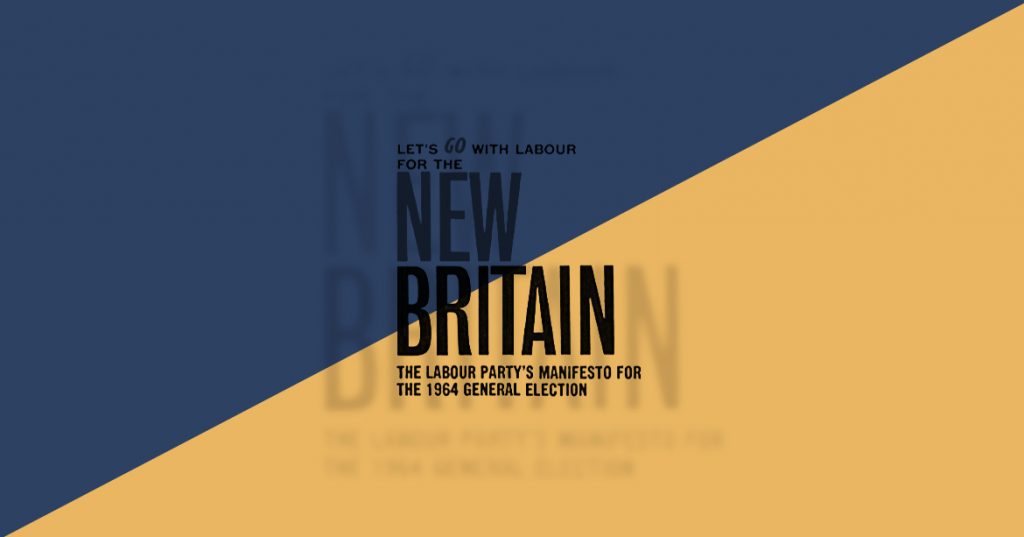
Different ITV companies specialised in different sports. If there’s swimming on ITV, it’s a solid bet that it’s TWW cameras. If there’s horse racing, the OB equipment comes from Rediffusion. And if it’s show jumping, then it’s a Southern production. Southern had a long – and mutually fruitful – relationship with the All England Jumping Course at Hickstead in Sussex and would produce programmes for the network, as here, or just for their own viewers. Either way, Raymond Brooks-Ward (1930-1992), who pioneered the idea of commentating on show jumping, was always there, on his own or with Dorian Williams. He moved to Grandstand on BBC-1 in 1982, as Southern’s successor TVS had little interest in the sport.
Small Time at 4.45pm makes use of Rediffusion’s continuity announcing team. Howard Williams, like most announcers, was an actor, with continuity being what he did when he was ‘resting’. This was a useful side job for actors who were voice trained and used to having to improvise and was more regular work than the after dinner speaking circuit. Ivan Owen, Williams’s co-performer, was also the voice of Fred Barker in the Five O’Clock Club, and provided the voice for Basil Brush opposite Rodney Bewes in the 1968 Friday evening BBC-1 series.
Day By Day is one of the longest of the daily magazine shows on ITV. This week, Monday’s edition runs to 40 minutes, Tuesday is 25 minutes, Wednesday 35 minutes, Thursday 35 minutes and today 35 minutes. Most other magazine shows at this time hover around 15 minutes, reaching 25 minutes for editions with a sports report on the end. For Southern, this creates an odd 20 minute gap between the end of Day By Day and the start of network prime time programmes at 7pm. Each day they fill it with a short local production. Today it’s the famous Out of Town with Jack Hargreaves (1911-1994). Hargreaves was the face of the station, Mr Southern, synonymous with their output. He had originally been hired by the company to be an executive, commissioning Southern productions as Assistant Programme Controller. But he was so popular in front of the camera in his first programme – Gone Fishing – that he came up against the Independent Television Authority’s rule that an individual can be an executive at a company or a star on that company… but never both. He chose to stay on screen, and continued to act as a programme controller unofficially.
The Celebrity Game at 7pm is what would evolve into NBC’s Hollywood Squares in 1965, and ATV’s Celebrity Squares in 1975. Viewers send in yes-or-no questions for the celebrities to answer, and contestants must guess – and give reasons for – what each celebrity will say. Each correct answer gains them £10 (up to the ITA’s maximum of £1,000), whilst three wrong answers in a row sends them home. Viewers sending in questions get a £1 Premium Bond if their question is used. As ever, Rediffusion is able to use its might as the backbone of ITV to pull in at least one huge star for each edition. The first show had Groucho Marx; tonight sees movie star Kenneth More answering questions.
8.25pm sees Stars and Starters. This is an frankly insane hybrid between the nightclub variety show Stars and Garters and Independent Television’s horse racing coverage team, who are here to commentate on greyhound racing from West Ham. It’s all for charity, unsurprisingly – the Variety Club of Great Britain.
ITV had no choice in the placement of Party Political Broadcasts. They could either show them when the BBC showed them, or not show them at all. And the ITA was clear: not showing them at all was really not an option. This creates problems for ITV schedulers – the BBC happily runs everything 15 minutes later than usual, but ITV like to get back on track to allow certainty for advertisers. Tonight’s placement of the Labour Party’s broadcast puts them in a really awkward position. The space between the news and the broadcast has to be filled with something, but is only 20 minutes, so Rediffusion invent a quick jazz programme. But the 12 minutes between the broadcast ending and a decent 10pm starting time is impossible to fill, so programmes until about 11.30pm have to run with a weird 8 minute offset to make up for it. However, this is only admitted to in the London TVTimes. In the Southern edition, the programme times are rounded off, so viewers are told to expect It’s a Woman’s World at 9.45pm when it actually airs at 9.48pm; Southern viewers are told to tune into Call in on Carroll at 10.40pm, but will actually have to wait 8 more minutes, until 10.48pm, for the show to actually start. And the news headlines, advertised as being at 11.10 are actually at 11.18pm. All in all, very unsatisfactory for the ITV network, the viewers and the advertisers. One wonders if the BBC did it deliberately.
Labour’s party political broadcast itself was a powerful one. The opinion polls said there was a definite swing to Labour to be seen, but it ranged from 2.75%, which gave the Conservatives a majority of 30, to 4%, giving Labour a majority of 23. An election had to happen by mid-October, so clearly there was all to play for. Labour chose the name “A New Britain” for both this broadcast and its manifesto. Both looked forward to the 1970s, and how Britain could use ‘the white heat of technology’ and Labour’s ‘new thinking’ to turn the country from the backward-looking, ageing, ‘dirty’ country it had become after 13 years of Tory rule into a forward-looking, young and bright nation ready to take on the challenges of automation, housing and education.
It was a powerful message, although it didn’t sit very well with a lot of middle Britain, who were perfectly happy for the country to plod on as it had been, since those 13 years had been ones of growth, low inflation and calm after the changes of World War II and the Attlee revolution. To try to reach those people, Labour contrasted the recently appointed Prime Minister, Alexander Frederick Douglas-Home, former 14th Earl of Home, former Lord Dunglass, Scottish landowner, Eton Old Boy, and Chamberlain’s right-hand-man during the years of appeasement before the war with the younger, hipper, working class Grammar school boy Harold Wilson. They were helped by the fact that the high contrast and ‘silver glow’ of black and white 405-line television made Home look like a very very old man – in repose, his bald head looked like a skull. In contrast, Wilson looked young and determined and was happy to try to compare himself with the late John F Kennedy.
In the end, this contrast between backward and forward, between old and young, between chugging industry and robotic automation, would swing the election for Labour – just, with a majority of 4.
Tonight’s big play, at 9.45pm (well, 9.48pm, but we’ve covered this) is by Margaret Drabble and is another of those programmes only Granada could make. 1964 is before ‘feminism’ is really a thing. There are ‘women’s libbers’ around, but they’re not much to be seen on television – they’re not even the butt of male comedian’s jokes, the peak of that would be a decade later. But subtle feminist thought is there, and finds expression in Granada’s play series It’s a Woman’s World. This play, ‘Laura’, is one of the first to address post-natal depression, then not accepted by most (male) doctors as an actual thing. It also, and this is a retrospective call, covers the absence of paternity leave rights for men: once Patricia England’s character has had her baby, her husband goes back to work, leaving her alone with a screaming child in a home in the middle of nowhere, her only contact with adult humans being with travelling salesmen – which is no better than not having any human contact at all. As always, Drabble puts suitable twist on all of this, so the main message may not have been seen by male viewers. But the play spoke directly to female viewers as she intended it to.
11.12pm is ITN’s foreign news programme. News from outside the UK was not popular with viewers; news from outside the Commonwealth and the United States was seen as audience poison. ITN’s main bulletins therefore concentrated on what was happening in the UK in particular, with trips abroad limited to later in the bulletin and firmly from English-speaking countries. But it was not possible to completely ignore world news, so ITN places it in Roving Report – perhaps something of a ghetto, but good to see anyway. This was one of the programmes that would be folded into the new News at Ten in 1967, the new programme daringly often leading with international stories and not shy of giving the back quarter hour over to one whole story filmed on location somewhere where English was not spoken.
About the author
Kif Bowden-Smith is the founder of the Transdiffusion Broadcasting System. Russ J Graham is the editor-in-chief.

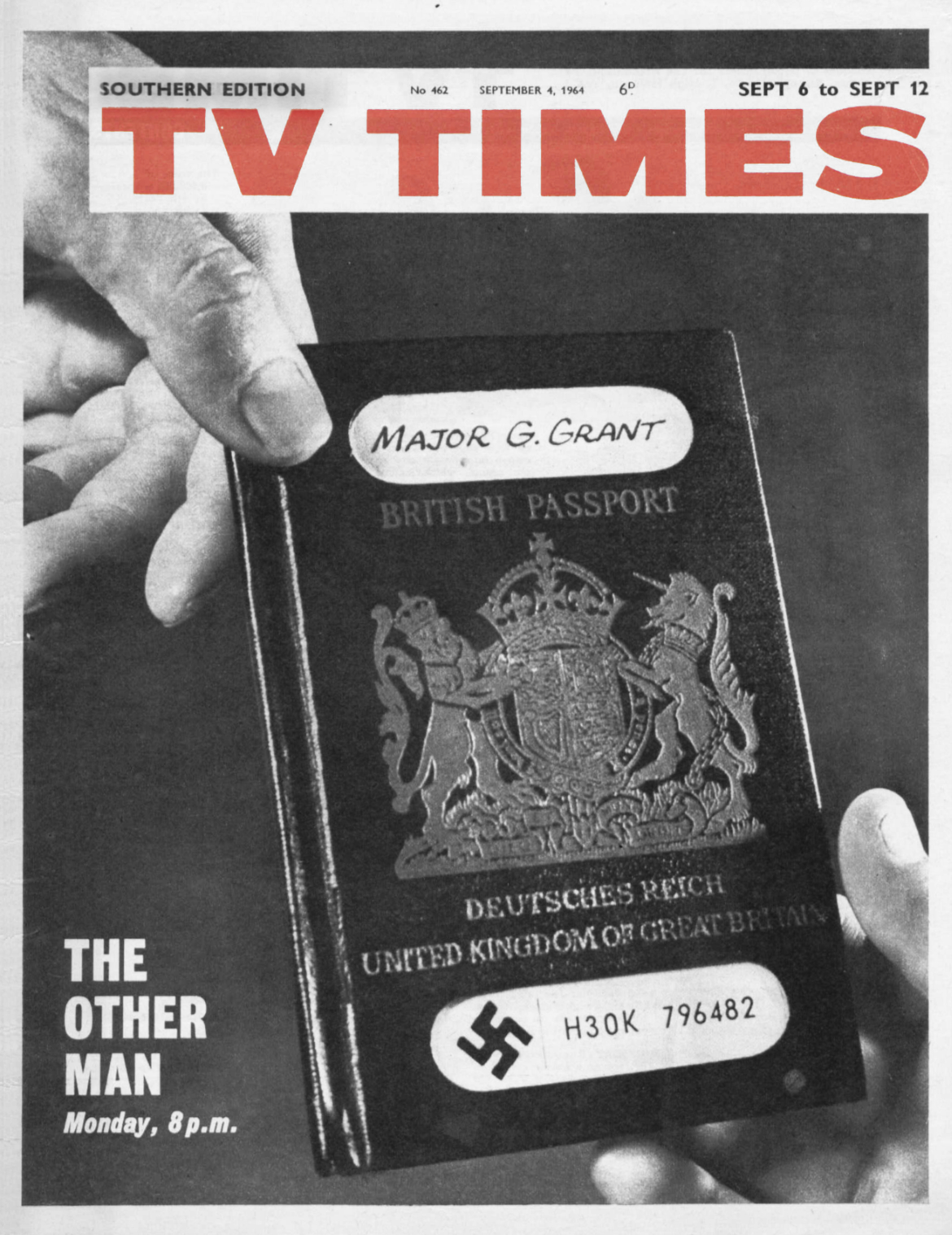
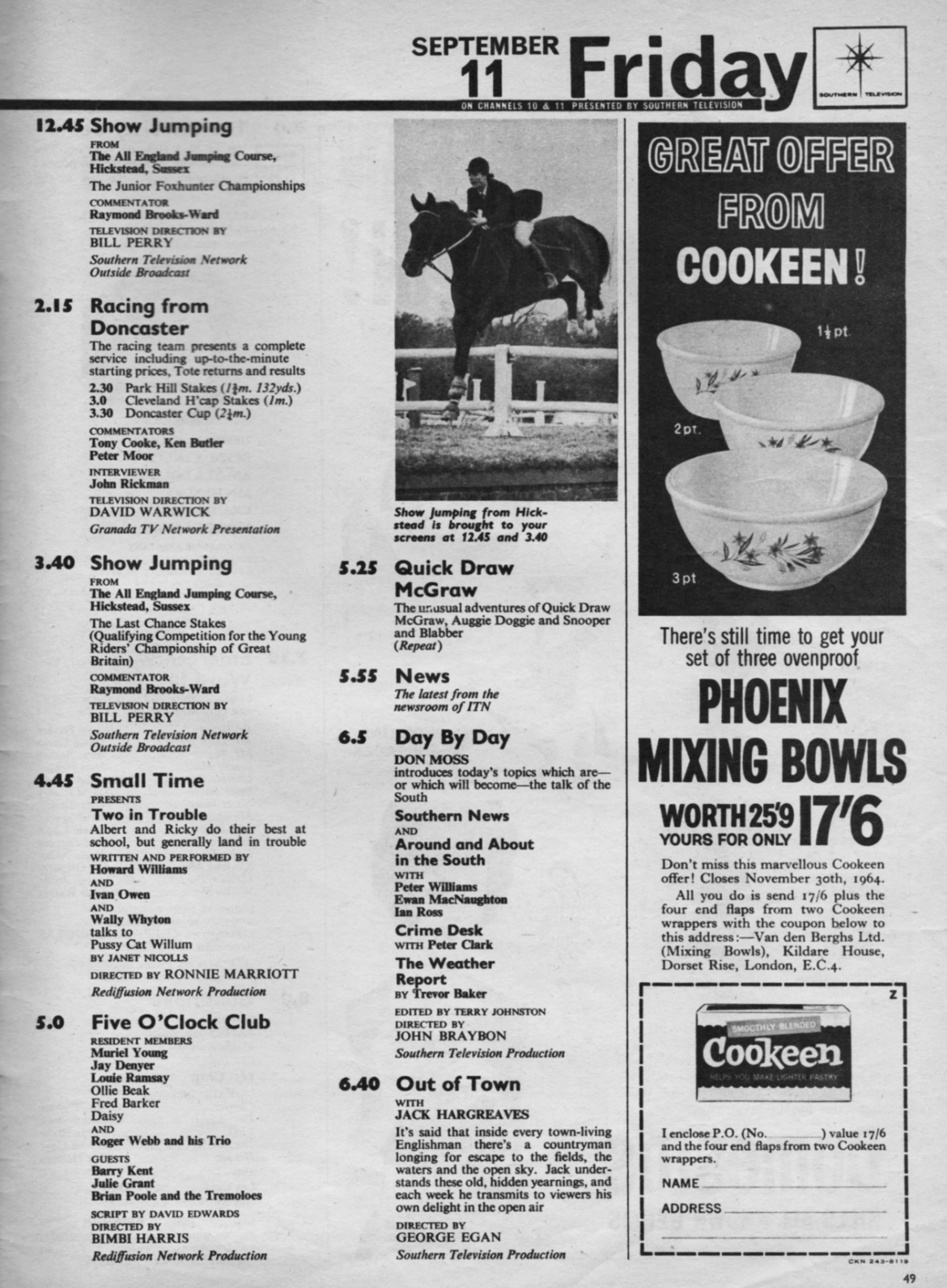


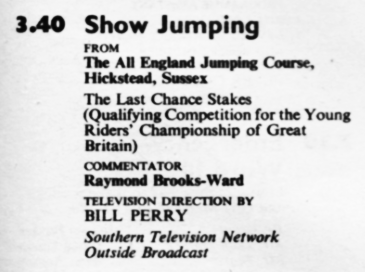
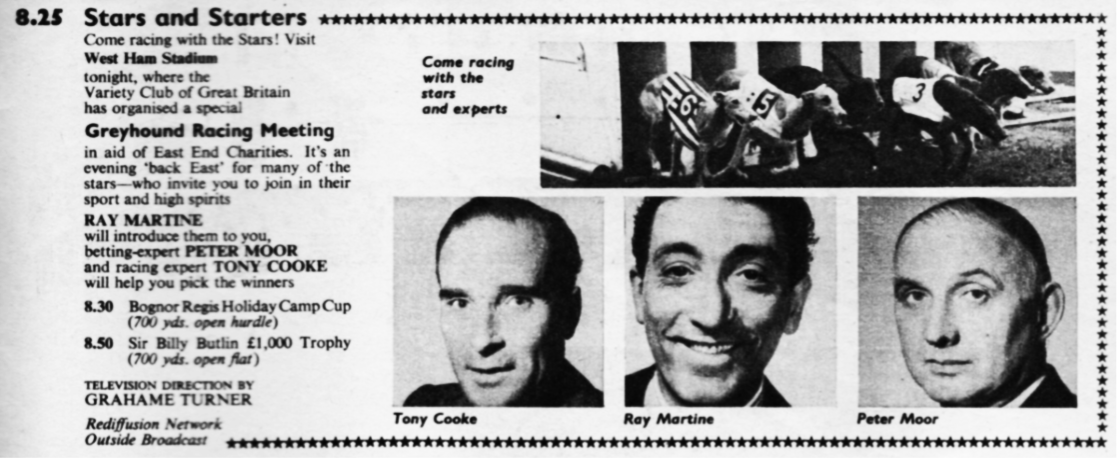


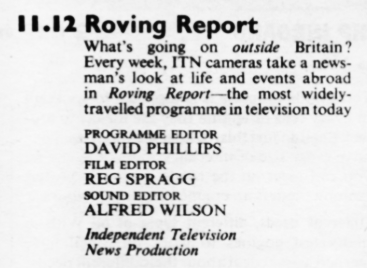
The one and only US show for that day was a repeat of Hanna Barber’s Quick Draw McGraw (1959), the successor to The Huckleberry Hound Show and just as funny. As well as the Quick Draw McGraw segment, there was Snooper and Blabber + Auggie Doggy and Doggy Daddy.
Kif and Russ, Groucho MARX. No marks on me already!
Bloody autocorrect!
These days,a PPB is given ‘by’ rather ‘on behalf of’
I am aware that Independent Television in the South brought us show jumping during the 1960s and the late great Raymond Brooks-Ward commentating on the event. Southern Television ceased transmission on Thursday 31st December 1981 after 23 years on air and its successor Television South which began on Friday 1st January 1982 and they relinquished show jumping coverage to the BBC. Roving Report was dropped from the ITV scheduled at the end of June in 1967 to make way for News at Ten which started on Monday 3rd July 1967.
In 1964, was the 7 hour daily limit of regular programmes firmly in place, or could ITV companies use more hours on one day, and then less on another, to ensure they did not breach the 50 hour maximum weekly ration?